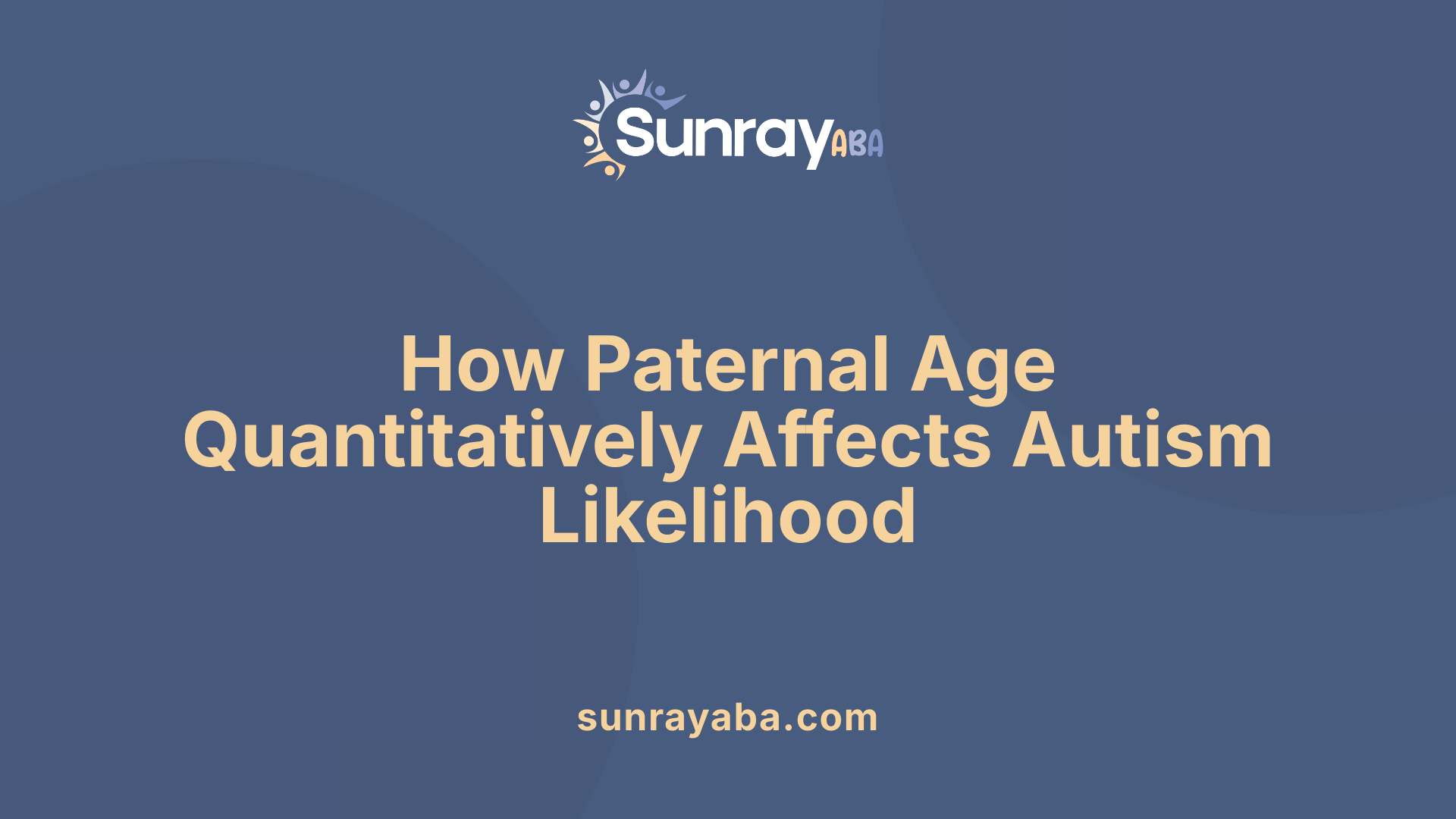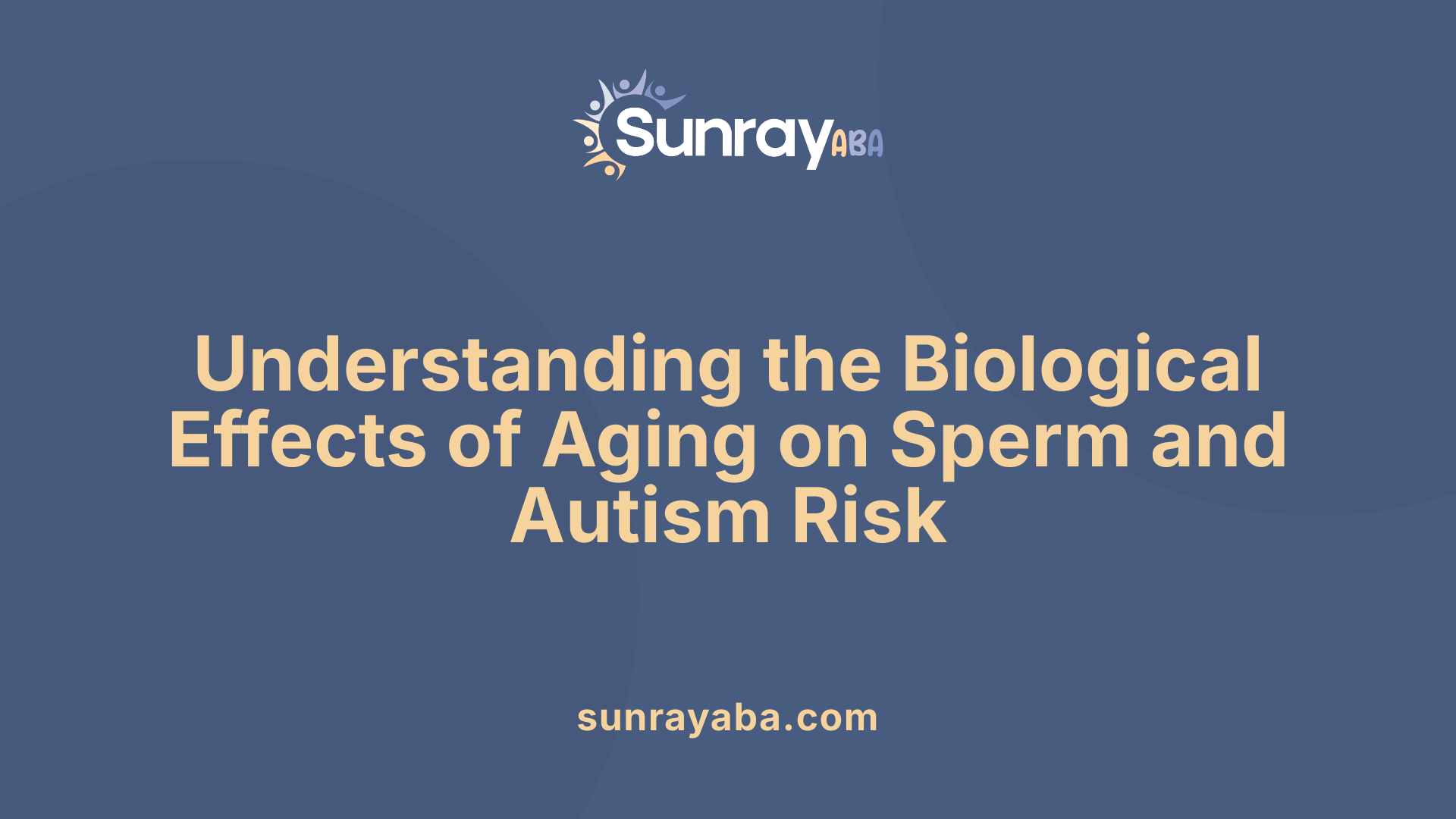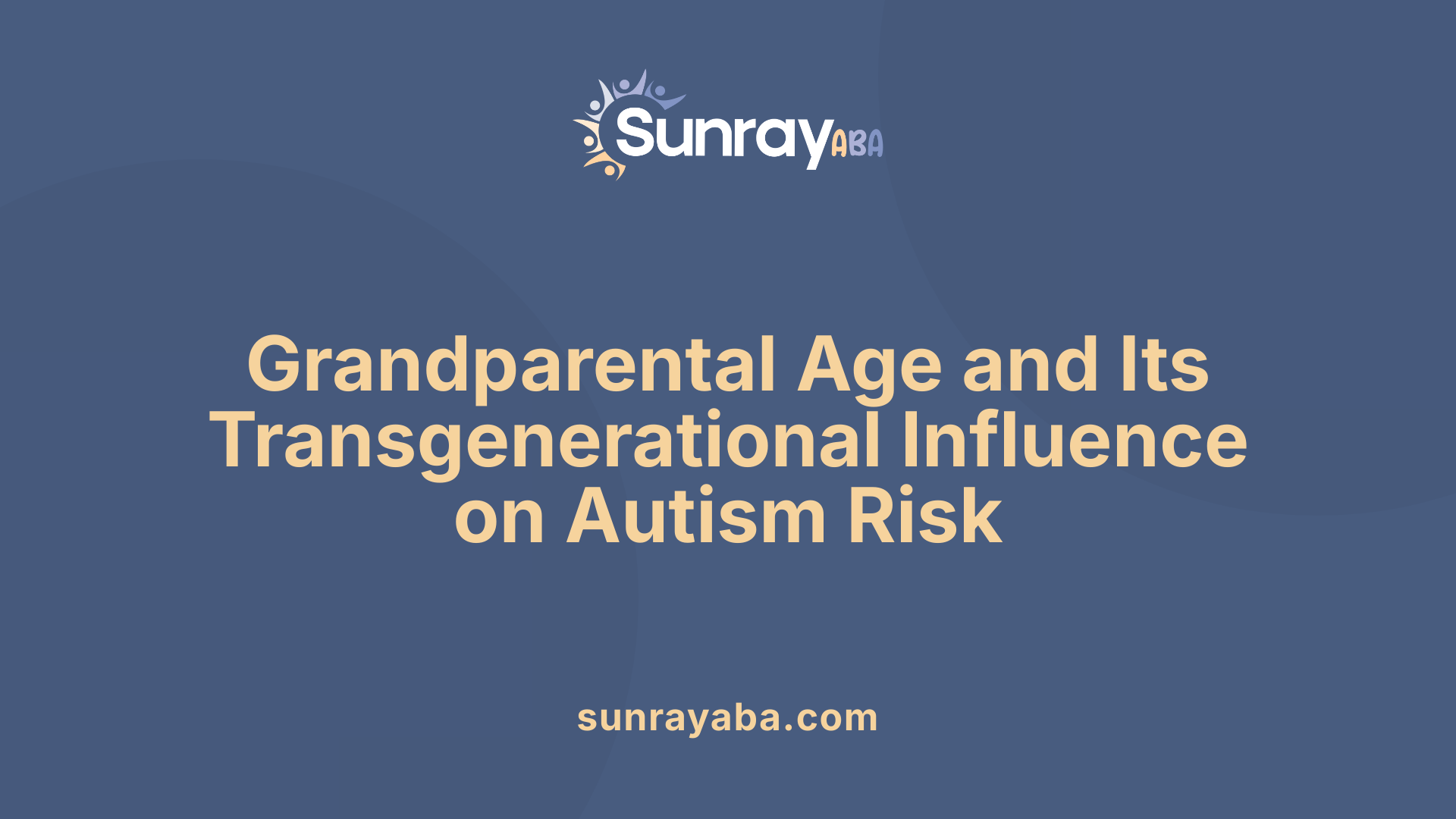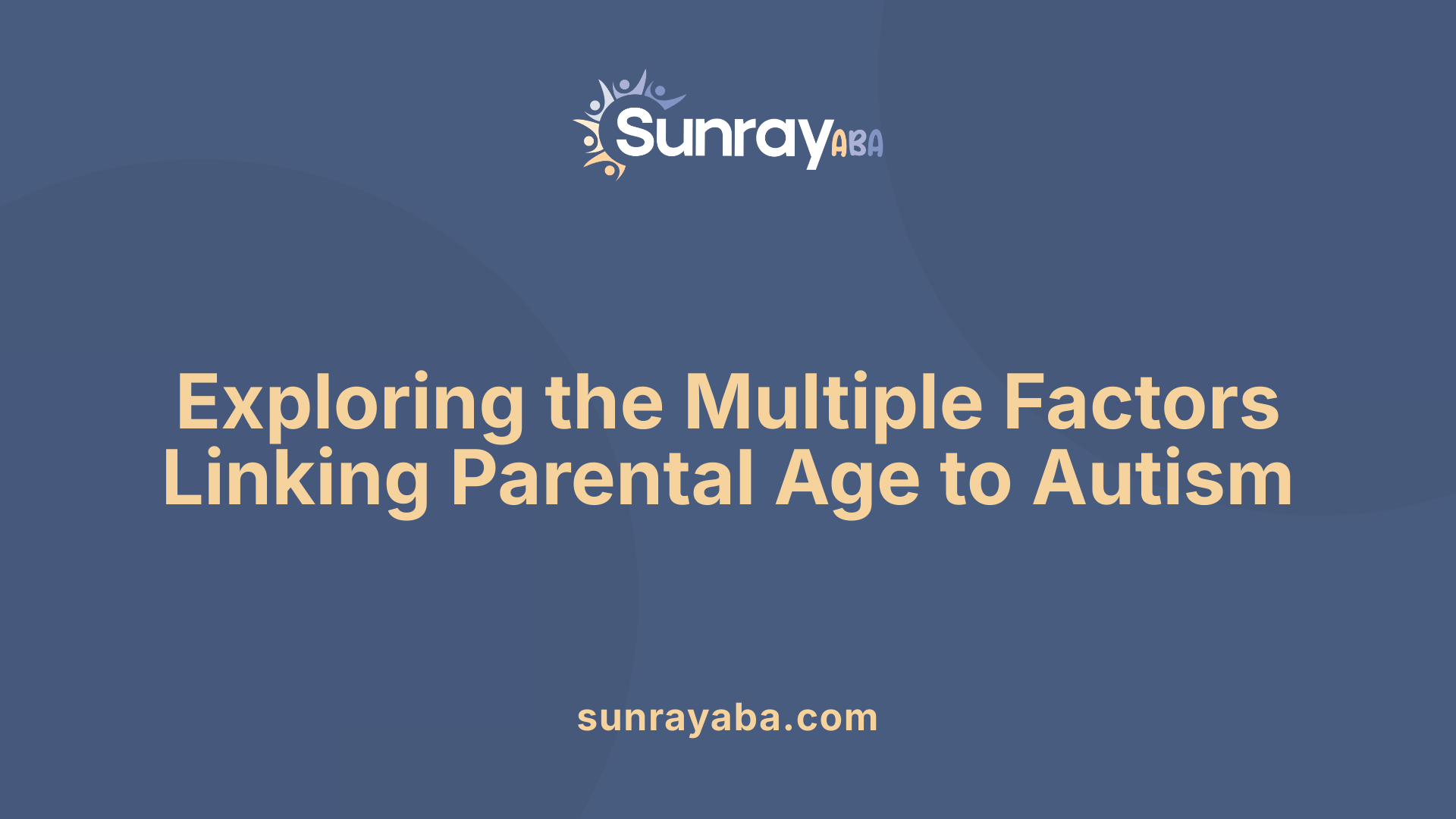Do Older Fathers Cause Autism?

Understanding How Parental Age influences Autism Spectrum Disorder
Recent research has increasingly highlighted the potential impact of parental age, especially paternal age, on the risk of autism in children. As societal trends shift towards later parenthood, understanding the biological and genetic mechanisms behind this association has become crucial. This article examines existing scientific evidence, explores potential causes and mechanisms, and discusses the complexities and debates inherent in this field of study.
Association Between Paternal Age and Autism Risk
What is the scientific relationship between older paternal age and autism spectrum disorder?
Multiple studies across different populations consistently indicate that the age of a father at the time of his child's birth influences the risk of autism spectrum disorder (ASD). Epidemiological research from countries such as Israel, the United States, Denmark, and Sweden show that children born to older fathers are more likely to develop ASD.
For example, a 2006 Israeli study found that men in their 30s are about 1.6 times more likely, and those in their 40s are up to six times more likely, to have children with autism compared to men under 30. Similar international analyses involving over 5.7 million children identified that the prevalence of autism increases with paternal age. Children of fathers over 50 years old have about a 66% higher chance of developing ASD than those with fathers in their 20s.
These studies suggest a steady gradient: as paternal age advances, so does the risk. Other neurodevelopmental conditions, such as ADHD and schizophrenia, also show increased odds with older fathers. For instance, children of men in their 40s have about a 28% higher probability of autism, while those of men in their 50s face approximately a 66% higher risk.
One prominent biological explanation is the accumulation of spontaneous genetic mutations, called de novo mutations, which increase with paternal age. As men age, their sperm cells undergo many more divisions, leading to more mutations that can influence brain development. Research indicates that each additional year of paternal age is associated with the transmission of about two extra mutations.
While the mutation hypothesis is significant, other factors such as epigenetic changes and inherited genetic predispositions are also considered. Importantly, most children born to older fathers do not develop autism, which highlights that paternal age is just one among many factors influencing ASD risk.
In summary, the correlation between increased paternal age and a higher likelihood of autism is well-supported by extensive research. The relationship is largely attributed to genetic mutations accumulated over time, but complex interactions with environmental and other genetic factors are also involved.
Quantifying the Increased Risk with Parental Age

How does paternal age influence the likelihood of having an autistic child?
Older paternal age has been linked to a higher chance of autism in children. Large-scale studies across many countries, including the US, Sweden, Denmark, and Israel, show consistent patterns. For example, research based on international data covering over 5.7 million children finds that the risk of autism increases as fathers age.
In specific statistics, men in their 30s are about 1.6 times more likely to have an autistic child compared to men under 30. The risk grows more substantial in the 40s; children of fathers in their 40s are approximately six times more likely to be diagnosed with autism than those with younger fathers.
The risk escalation continues with age. Fathers over 50 have about a 75% higher chance, and those over 55 may see their children's autism risk increase by fourfold. This pattern supports the idea that genetic mutations accumulate in sperm as men age, which can influence brain development in their offspring.
Although these relative increases are notable, the absolute risk remains relatively low. For instance, the baseline probability of autism in children of parents in their 20s is around 1.5%. For children of older fathers, this might rise slightly, to about 1.58% for those whose fathers are in their 40s.
This indicates that, while paternal age significantly influences autism likelihood, it is only one of many factors. Genetic mutations passed through sperm increase with age, but most children born to older fathers do not develop autism. Complex interactions between genetics, environment, and parental age continue to shape understanding of autism risk.
In summary, advancing paternal age correlates with increased odds of autism, supported by extensive research. This association highlights the importance of considering paternal age as part of broader genetic and environmental risk assessments in autism.
Biological Mechanisms Linking Father’s Age and Autism

What are the potential mechanisms by which older fathers may influence autism risk?
Research indicates that several biological processes might explain why children of older fathers have a higher likelihood of developing autism. One of the primary mechanisms is the accumulation of de novo genetic mutations in sperm cells as men age.
Male germ cells undergo numerous divisions over time, increasing the chance of copying errors—known as mutations—that are passed on to offspring. These mutations can interfere with normal brain development, contributing to autism spectrum disorder (ASD). For instance, studies have shown that approximately two additional mutations are transmitted per year of paternal age.
In addition to genetic mutations, epigenetic modifications—changes in gene expression regulation without alterations in DNA sequence—also play a role. As men age, DNA methylation patterns in sperm tend to change, which can affect how genes are turned on or off in the developing embryo.
Oxidative stress is another factor. Aging germ cells are more exposed to oxidative stress, which can damage DNA, causing further mutations. This damage may influence developmental pathways important for neural development, increasing autism risk.
Finally, these genetic and epigenetic alterations might not act alone. They could interact with inherited genetic predispositions or environmental factors, amplifying their impact.
Overall, the convergence of accumulated mutations, epigenetic changes, and cellular stress in aging paternal germ cells offers a compelling biological explanation for the observed association between older paternal age and increased autism risk in children.
The Impact of Grandparental Age on Autism in Offspring
 Recent research highlights how both parental and grandparental ages can influence the likelihood of autism spectrum disorder (ASD) in children. Studies consistently show that older parents, especially mothers over 40 and fathers over 50, are linked to a higher risk of autism. This increase is thought to be largely due to accumulated genetic mutations and epigenetic changes that happen as men and women age.
Recent research highlights how both parental and grandparental ages can influence the likelihood of autism spectrum disorder (ASD) in children. Studies consistently show that older parents, especially mothers over 40 and fathers over 50, are linked to a higher risk of autism. This increase is thought to be largely due to accumulated genetic mutations and epigenetic changes that happen as men and women age.
Among older fathers, the correlation with autism risk is particularly strong and well-documented. For example, data indicate that children of fathers over 50 are about 1.6 to 1.7 times more likely to develop ASD compared to those with fathers in their 20s. This is primarily attributed to spontaneous mutations — known as de novo mutations — which increase in sperm as men age. Each additional year of paternal age is associated with approximately two extra mutations passed on to the child.
Beyond direct parental effects, recent evidence suggests that the ages of grandparents at the time their children have offspring also matter. In studies based on Swedish national registers, grandchildren of grandfathers aged 50 or older showed a significantly higher risk of autism—about 1.7 to 1.8 times greater—compared to those with younger grandfathers. This indicates that genetic or epigenetic factors related to extended lineage age may build up over generations, influencing autism risk.
The mechanisms behind this transgenerational influence are complex. Increased mutations in germ cells, and alterations in epigenetic tags—chemical modifications that regulate gene activity—are believed to carry over across generations. These changes possibly accumulate, heightening the vulnerability to neurodevelopmental conditions such as autism in descendants.
In summary, both the direct effects of parental age and the indirect effects of grandparental age contribute to autism risk in a way that underscores the importance of genetic and epigenetic inheritance. While older parental ages are associated with increased mutations, the impact of grandparental age highlights potential long-term genetic influences, adding a new dimension to understanding autism's complex origins.
Genetic, Environmental, and Biological Factors in Age-Related Autism Risk
 Older parental age, particularly the father's, has been consistently linked to an increased likelihood of autism in children. This association is largely believed to stem from biological and genetic changes that accumulate over time in reproductive cells.
Older parental age, particularly the father's, has been consistently linked to an increased likelihood of autism in children. This association is largely believed to stem from biological and genetic changes that accumulate over time in reproductive cells.
One prominent explanation involves de novo mutations—these are new genetic alterations present in the child but absent in parental DNA. As men age, their sperm cells undergo numerous divisions, increasing the chance of spontaneous mutations. Studies estimate that each year of paternal age adds approximately two new mutations in sperm DNA, which can disrupt genes critical for brain development. These mutations can interfere with neurodevelopmental pathways, contributing to autism risk.
In addition to genetic mutations, epigenetic changes—such as modifications to DNA methylation patterns—may also be involved. These changes can affect gene expression without altering DNA sequences and are influenced by aging processes.
On the maternal side, age-related factors include increased risk for chromosomal abnormalities like Down syndrome and other obstetric complications that may impair fetal development. Maternal health issues such as diabetes and obesity are more common with advanced age and can negatively impact the developing brain of the fetus.
Environmental exposures during pregnancy further complicate the scenario. Maternal infections, immune activation, and exposure to toxins have been linked to altered neurodevelopment, increasing autism risk. Both maternal and paternal aging can affect immune system functioning, leading to increased inflammation or immune dysregulation that may influence fetal brain development.
Transgenerational influences suggest that the ages of previous generations also matter. For instance, research indicates that grandfathers' age at the time their children are born affects autism risk in grandchildren, possibly due to accumulated genetic mutations transmitted through generations.
Overall, the interplay of genetic mutations, epigenetic alterations, environmental exposures, and health issues associated with aging parents creates a complex web of factors impacting autism risk. Continued research aims to unravel these interactions to better understand and potentially mitigate risks associated with advanced parental age.
Debates and Limitations in Current Research
What are the limitations and debates within scientific research regarding paternal age as a risk factor for autism?
Research examining paternal age as a contributor to autism risk yields a complex picture marked by ongoing discussions about causality and the underlying mechanisms. Numerous studies confirm that children of older fathers have a higher likelihood of developing autism spectrum disorder (ASD), yet this increase is generally modest. For instance, children born to men over 40 are about six times more likely to have autism than those born to men under 30, but the absolute risk remains relatively low.
A major challenge lies in distinguishing whether paternal age directly causes autism or merely correlates with other risk factors. Many hypotheses suggest genetic mutations—specifically de novo mutations—accumulate in sperm as men age, which may influence neurodevelopment. However, evidence indicates that these mutations are only part of the story. Some studies, including research in Iceland and Sweden, imply that other factors, such as epigenetic changes or inherited psychiatric conditions, may also play significant roles.
Methodologically, many studies face limitations. Most research relies on observational data, which cannot definitively establish causation. Differences in study designs, populations, and data analysis methods can lead to inconsistent findings. Biases such as reporting biases, confounding variables like maternal age, socio-economic factors, and genetic predispositions further complicate interpretations.
The interactions between genes and environment are also highly complex. While increasing paternal age is associated with greater mutation rates in sperm, how these mutations translate into neurodevelopmental disruptions remains unclear. Moreover, some research suggests maternal age plays a more significant role, and the combined effects of both parents’ ages must be considered.
In sum, although a correlation between advanced paternal age and increased autism risk exists, establishing a direct causal link remains challenging. The current research emphasizes the need for further studies that can disentangle the intricate genetic, epigenetic, and environmental factors involved in autism etiology, and clarify the true impact of paternal age on the risk.
Inheritance Patterns and the Role of the Father's Genetics

Is autism inherited, and does it come from the father's side?
Autism has a considerable genetic component, with heritability estimates often ranging between 40% and 80%. This indicates that genetics play a significant role in the likelihood of developing autism, and these genetic factors can be inherited from either parent. However, recent studies highlight the importance of the father's genetic contribution, especially in families with multiple affected children.
Research shows that siblings with autism tend to share about twice as much genetic material from their father compared to their mother. This pattern suggests that the father’s genome may have a more influential impact on autism risk than previously recognized, especially in high-risk families.
While some genetic predispositions to autism are inherited, approximately 20% of cases result from spontaneous (de novo) mutations. These mutations occur anew and can originate from either parent, but the process of male sperm cell division makes older men more prone to passing such mutations. As men age, their sperm accumulate more mutations due to the numerous cell divisions required for sperm production.
Overall, the inheritance of autism involves a complex interplay of genetic factors from both parents. Emerging evidence indicates that the father's genetic material, particularly mutations accumulated over time, may have a notable influence on the child's autism risk. This highlights the significance of paternal age and genetic contribution when considering autism’s inheritance and development.
Wrapping Up: The Multifaceted Nature of Autism Risk
Although substantial evidence links older paternal age to an increased risk of autism, it is clear that this factor alone does not account for the rising prevalence of ASD. Genetic mutations, epigenetic changes, environmental influences, and broader societal trends all intersect to shape autism risk across generations. As research continues, a nuanced understanding of the mechanisms involved will be key to developing targeted interventions and informing prospective parents. The complex interplay of inherited and acquired factors underscores that paternal age is a significant piece of a larger puzzle, but not the sole cause of autism.
References
- The link between parental age and autism, explained | The Transmitter
- Does Older Sperm Cause Autism? - Healthline
- The Association Between Parental Age and Autism-Related ...
- Older grandfathers pass on autism risk through generations
- Large age-gaps between parents increase risk of autism in children
- Estimated Autism Risk and Older Reproductive Age - PMC
- The perils of putting off fatherhood: why it poses risks to children's ...
- Do Older Fathers Contribute to Autism? - Astra ABA
- The link between parental age and autism, explained | The Transmitter
- The Association Between Parental Age and Autism-Related ...